
Quick guides Productivity
8 tips to help prevent a work from home burnout

10 mins read
Start building your digital home with Happeo
Request a demoQuick guides Productivity
Product
Features
Solutions
Happeo for
Use cases
Resources
Explore
Support
Happeo For
Use cases
Comparisons
Explore
Support
Recent

Jonathan Davies
10 mins read
Let’s cut to the chase. The idea of working from home differs from reality.
In the last 18 months, most of us discovered just how challenging it is to work remotely, and how attaining a work-life balance can be even harder when your office is at home.
There has been a notable rise in mental health issues, and COVID-19 is taking its toll in so many ways. Burnout has always been an issue in the workplace, but now there’s a shift in focus in preventing work from home burnout.
Typically, burnout refers to the state of physical, emotional, and mental exhaustion that’s felt after extended exposure to periods of prolonged stress. In the context of work from home burnout, the stress is work-related—and it’s exacerbated by the environment you’re working in.
A recent survey revealed that 69% of employees were experiencing work from home burnout symptoms.
The survey found that over two-thirds, or 69%, of employees are experiencing burnout symptoms while working from home. That’s up almost 20% from a similar survey conducted in early May. The latest survey was conducted July 10 and surveyed 284 U.S. employees.
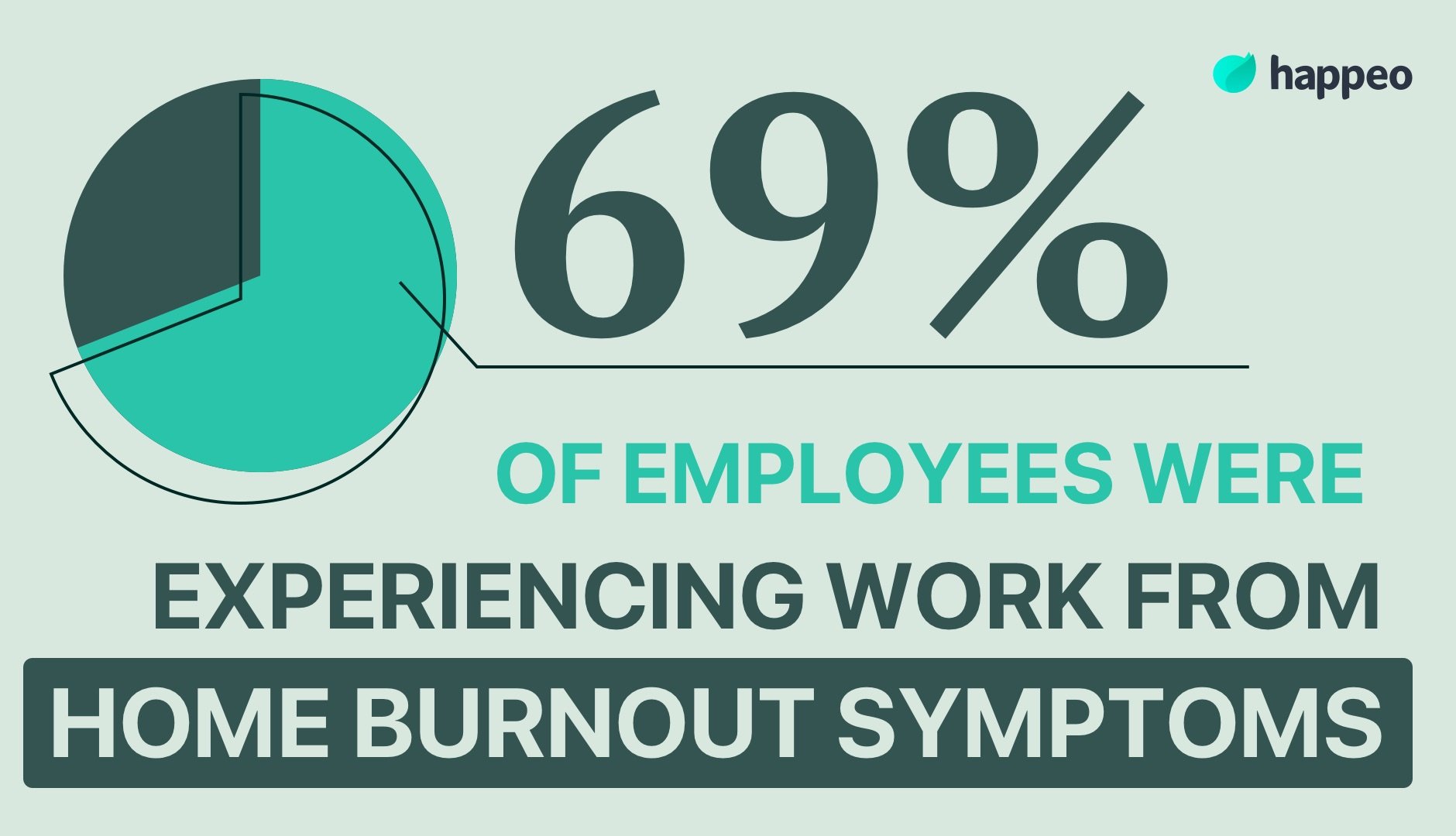
Prior to the pandemic, remote work was performed by employees on occasion, or by those who found that working from home better suited their or their employer's needs. It was optional, and there was still the option of attending face-to-face meetings, spending time in an office or coffee shop, and connecting with colleagues or clients in their environment. When social distancing measures and lockdowns arrived, this all fell away.
Watch video
Not only were we forced to work from home, our face-to-face connections vanished, and our ability to connect with people curtailed. Humans are social beings, and many people have struggled with the lack of interaction. Add to this the need to suddenly adapt to a new environment, systems and software, and to manage our workloads with reduced support structures, to balance home life, children and family, and to remain productive, and it’s easy to see why stress levels rose.
Then there are the constant health uncertainties, political unrest, and financial stresses, all of which Covid-19 heightened. Many people have also faced uncertainties over whether or not their jobs are secure, or if the company they work for will pull through. These factors put additional pressure on all sides, making burnout more prevalent.
According to an Eagle Hill survey conducted in August 2020, the majority of causes for work from home burnout came down to unrealistic expectations from employers.
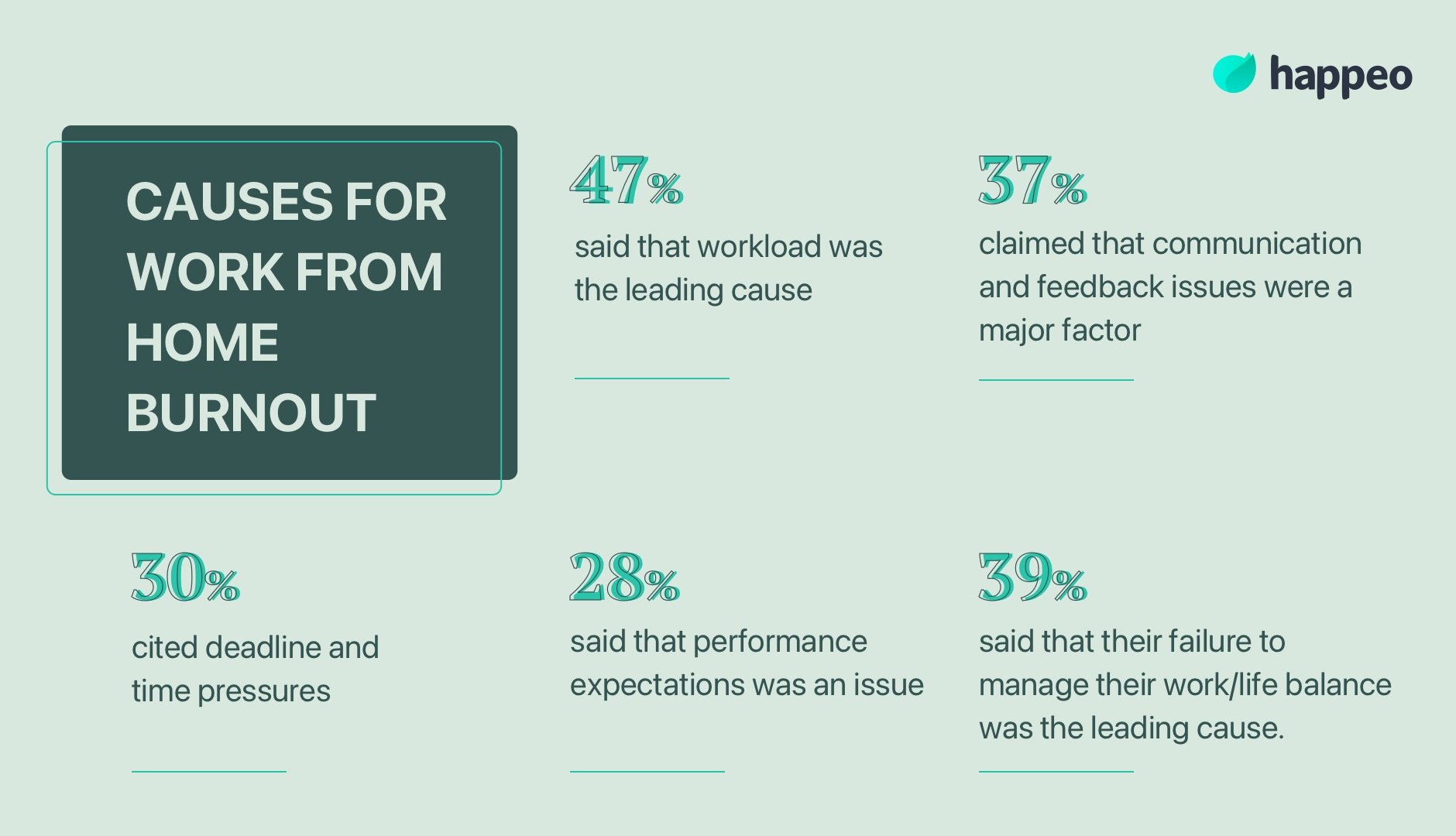
Burnout of any kind can cause many physical and mental conditions, from high blood pressure and heart disease to depression and anxiety. But there are several symptoms of work from home burnout that are now recognized as the most common.
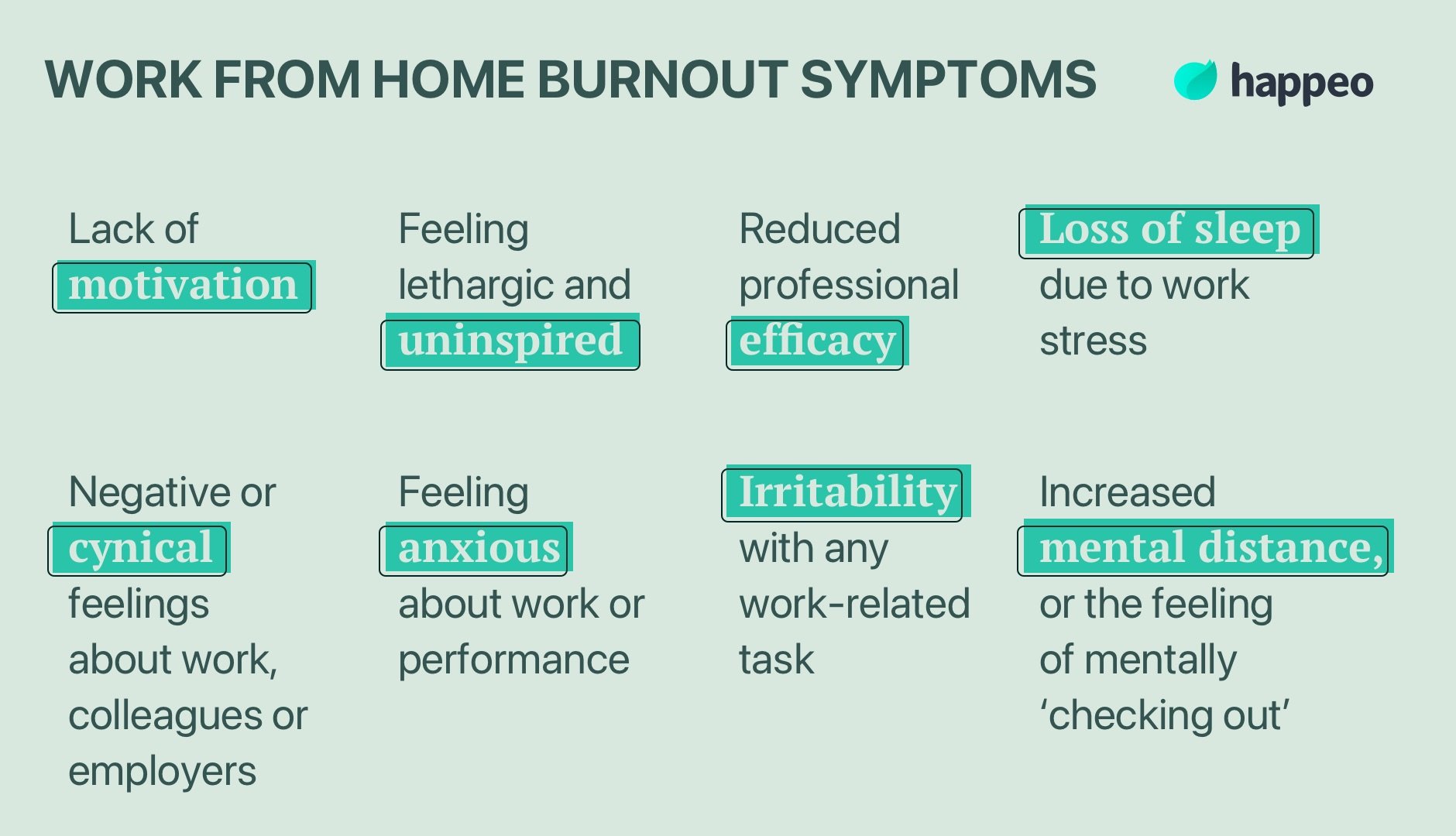
Even displaying one of these symptoms is a sign of burnout, and it’s important that they’re recognized for what they are. They don’t have to be severe either, they can manifest in different ways, in different people.
Knowing what to look for is important, as even a mild case of burnout can have a long-lasting effect. Of course, knowing how to prevent it is even better than curing it.
The following tips will help you reduce the chance of remote work burnout, keeping you motivated and productive.
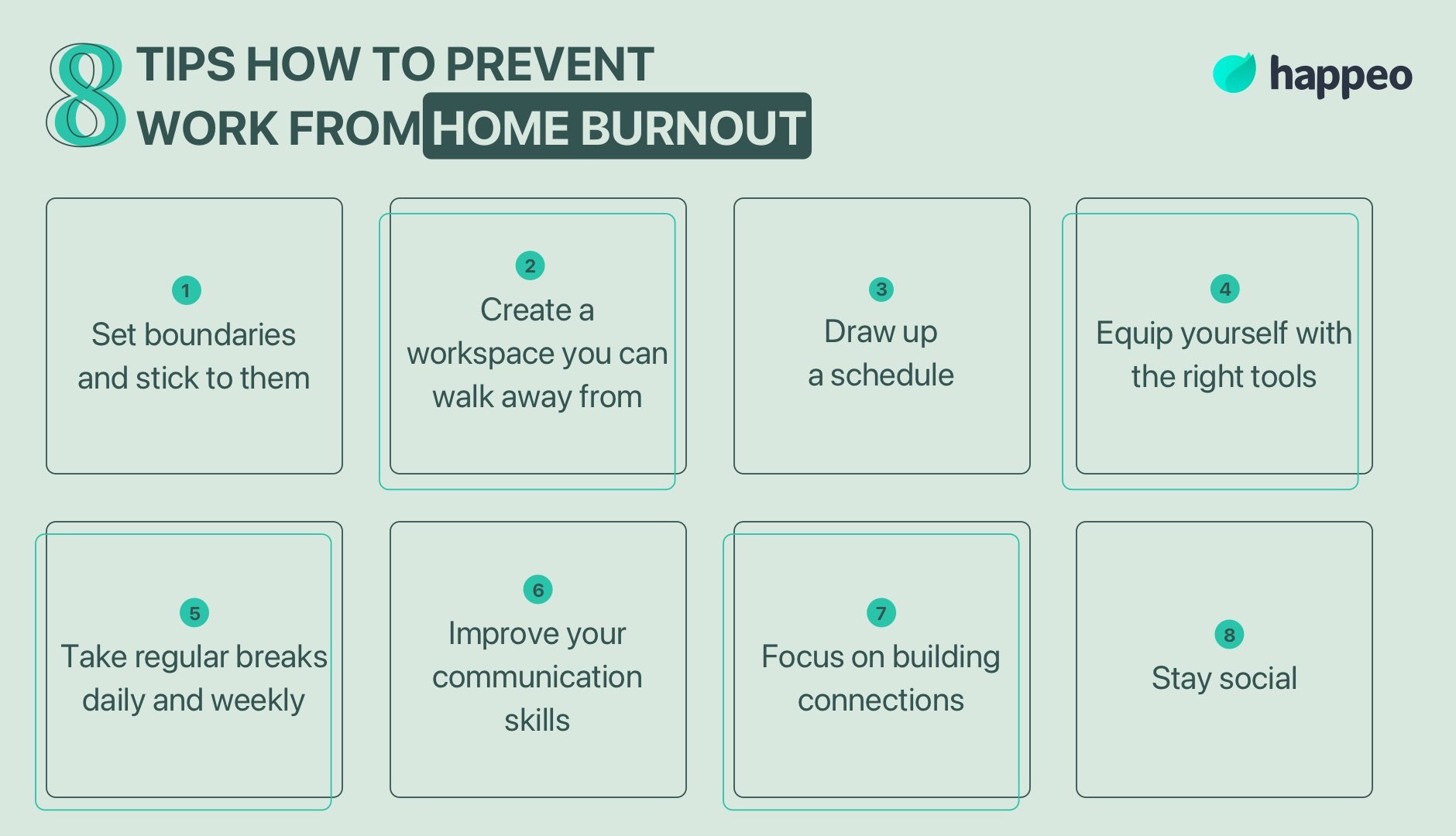
One of the biggest struggles that comes with working remotely is the lack of structure. If you want to work at an optimal level, setting your own boundaries is a crucial step in the right direction.
Take some time to sit down and consider what your priorities are and how you can best see to them every day. Consider what time you should wake up to accomplish your daily tasks, and how long (or short) your breaks should be in between work.
Working remotely will require you to parent yourself a little. In a working environment, structure and boundaries uphold action—so make sure you are creating and enforcing healthy limitations for yourself.
Without a separate workspace, your mind can start to feel hazy and unclear. Sleeping, eating, and working in the same environment may seem tempting at first, but this one-space-fits-all situation is more likely to hinder productivity than prompt it.
Setting up a workstation that is separate from other areas of the home is a luxury that not everyone can afford. But for those who can, this can really help to prevent work from home burnout. By setting up a clearly defined workspace in your home, you can help your brain to both engage with and disengage from work-mode at the appropriate times.
Drawing up your own schedule is paramount to unlocking remote working efficiency. Working alone means needing to take responsibility for how your day plays out, which is not something all of us are familiar with.
One way to combat working from home fatigue and streamline your productivity levels is to create a personal schedule that stretches across every day of the week. If you really crave the structure you can even draw up a month-long schedule at a time.
Seeing all of your tasks lined up ahead of time will give you much needed foresight. Plus, it allows you to manage your priorities with more diligence.
Download feature list
Having the right tools on hand can make all the difference to your relationship with remote working and self-management. In this regard, we speak mostly of software tools, many of which were created (especially over the past year) for this exact purpose.
There are scheduling tools, communication tools, remote collaboration tools and more available online. Use whatever tools you need to make remote work burnout less likely and give your productivity a boost.
When in the throes of work from home burnout it’s often really difficult to know when the appropriate time is to take a break. However, anticipating when your body and mind need a moment of rest will help your mind stay sharp and keep your energy levels afloat.
Both your body and your mind need to take frequent, well-timed breaks for you to prevent working from home fatigue. Studies have highlighted how remote work affects our sleeping pattern, so getting enough rest is crucial to your wellbeing. There is no shame in needing to take breaks. They are essential to your health and your productivity, so don’t be afraid to go forth and relax.
If communicating with your co-workers in a normal work environment is tough, communicating with them from an isolated location is… well, tougher. Being unable to communicate face-to-face with your team members is bound to feel restrictive. But there are ways to work around it.
First, familiarize yourself with the video call. We get it, they’re the worst, but they are also your new primary method of inter-team communication, so get used to it as best you can.
Taking time to improve your writing skills will mean more streamlined conversations and ultimately less back-and-forth between you and your team.
Now is as good a time as ever to expand your connections and build up a larger network of people you may want to know better or work with in the future.
Remote working is not going anywhere for the next few years, but networking is still an important part of business that you shouldn’t pass up. You may not attend as many dinner parties or conferences as you did in pre-pandemic times, but social media platforms are a good substitute.
Don’t allow your remote working situation to prevent you from connecting with like-minded individuals or potential future business partners. Step out of your comfort zone and reach out in new ways to foster both professional and personal connections with those in your sphere.
Remote working is about work, not your personal life.
Working from home can quickly become a slippery slope to unnecessary isolation as you become more and more comfortable alone in your own space. But cutting yourself out of whatever social gatherings are permitted in your area is not going to help.
If you’re living with family, friends, or a partner, make the effort to really connect with them socially at the end of your workday. If you live alone, do what you can to get out of the house as much as possible. Even a trip to the grocery store can be fun if you take a friend.
When it comes down to it, preventing work from home burnout starts with taking care of your mental and physical health. Do yourself a favor and have some fun every once in a while (outside of the house). You’ll reduce that feeling of working from home fatigue and feel far better about life when you return to your desk.
If you’re suffering from work from home burnout there’s no quick fix for recovery. It takes time to recover, and if you don’t properly address the underlying causes, you’ll end up back at square one.
The following suggestions all help you to recover and to regain your previous enthusiasm for your job.
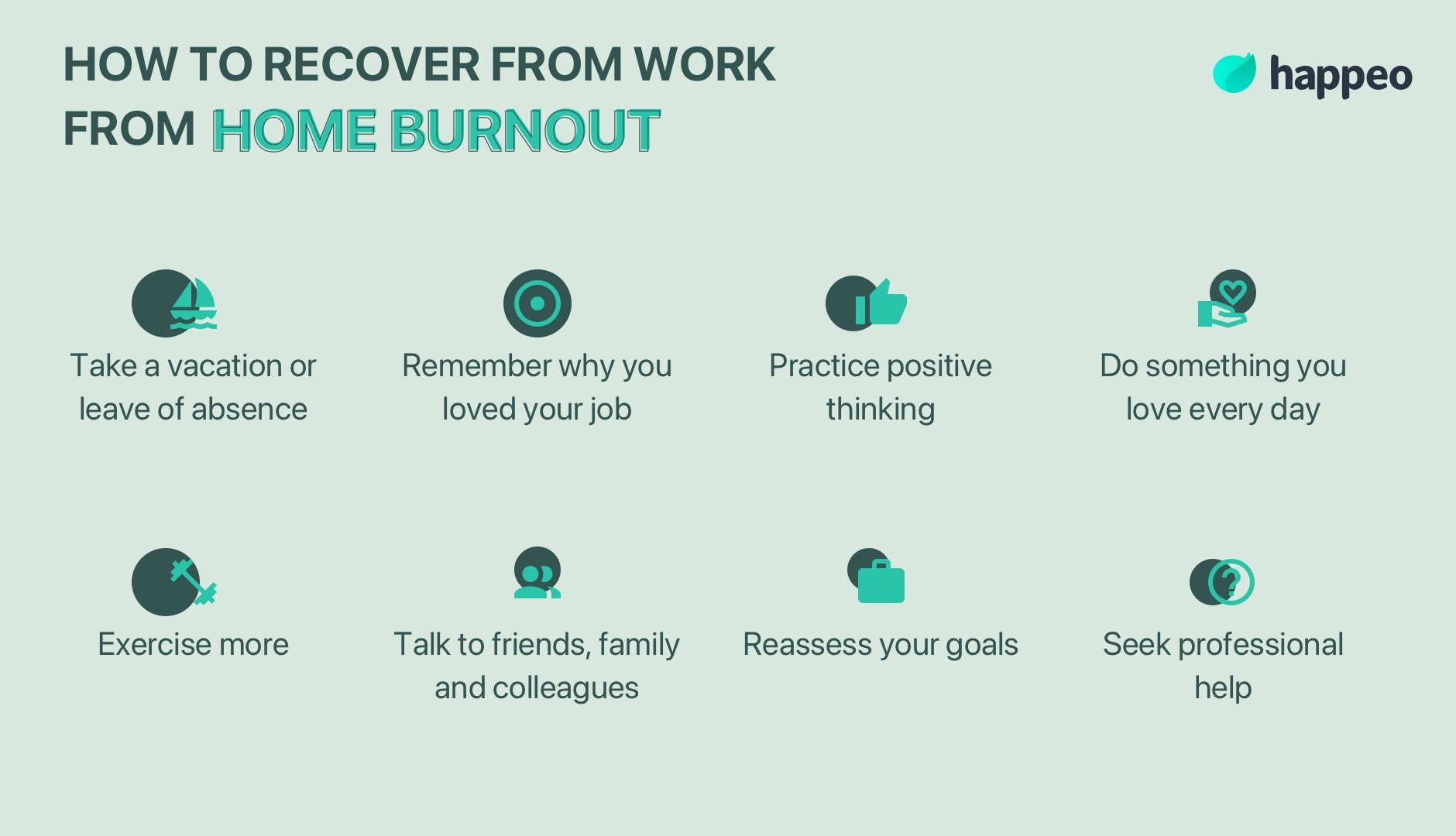
Book a demo
With work from home burnout on the rise, it’s harder than ever not to be a statistic. However, now that you’re equipped with the knowledge of what it entails, you can work towards being happier, healthier, and less stressed. You’ll feel better for it, and your productivity levels will enjoy a welcome boost. It's up to you to find the right tools and integrate them into your own company. Make sure that you find a solution that will fit your corporate culture, your company's needs and your employees' interests.
If you are interested in unlocking the value of remote work, book a demo with Happeo. We can help you improve employee engagement, internal communications, and even productivity.
